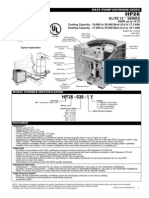Tensile & Hardness Testing
Uploaded by
Tasnuva HumayraTensile & Hardness Testing
Uploaded by
Tasnuva Humayra“Heaven’s Light is our Guide”
Rajshahi University of Engineering and Technology
(RUET)
Course No.: GCE2231
Course title: Principles of Materials Characterization
Topic: Testing of Materials-Tensile Testing and Hardness Testing
Submitted to:
Sharmin Mostari
Assistant Professor
Department of Glass & Ceramic Engineering
Rajshahi University of Engineering and Technology
Submitted by:
Name: Tasnuva Humaira
Roll: 1706002
Dept.: Glass and Ceramic Engineering
Submission date:02/12/2020
Testing of Materials- Tensile Testing and Hardness
Testing.
Introduction:
A material is a substance or mixture of substances that constitutes an object.
Material can be pure or impure, living or non-living matter. Material can be
classified based on their physical and chemical properties. Or on their geological
origin or biological function. To know whether a material is suitable or not for any
specific product, we have to test the material. Materials are tested for one or more
of the following purposes –
1. To access numerically the fundamental mechanical properties of ductility,
malleability, toughness etc.
2. To determine data, i.e, force-deformation (or stress) values to draw up sets
of specifications upon which the engineer can base his design.
3. To determine the surface or sub-surface defects in raw materials or
processed parts.
4. To check chemical composition.
5. To determine suitability of a material for a particular application.
Classifications of testing:
Considering the utmost utility of the material testing, various tests for
determining the properties and flaws in materials have become well
standardized.
Tests on materials may be broadly classified as :
a) Destructive tests- after being destructively tested, the component or
specimen either breaks or remains no longer useful for future use. Examples
of this type of testing are- tensile test, impact test, hardness test, bend test
etc.
b) Non-destructive tests- A component dose not break in this type of testing
and even after being tested so, it can be used for the purpose for which it was
made. Examples are- radiography, ultrasonic inspection etc.
c) Process inspection/tests- the name of process inspection may be come from
the type of manufacture where it is performed such foundry, welding
assembly etc. there is first piece inspection or final inspection, of sampling
and check inspections. The location often affects the name of the inspection,
as in receiving or incoming inspection, conveyor or hopper inspection, stores
or stock inspection. All of these are varieties or classes of process
inspections.
In this section we will deal with destructive test one is tensile testing and
another
is hardness testing.
Tensile Testing:
It is one of the most widely used mechanical test. A tensile test helps determining
properties such as tensile strength, yield point or yield strength, % elongation, %
reduction in area and modulus of elasticity. The following fig. shows a specimen
for tensile test. Since mechanical properties to some extent are influenced by the
size and shape of the test specimen, it is customary to use standardized specimen.
Fig . Tensile-test specimen.
The essential features of a round (cylindrical) test specimen are the diameter DO ,
parallel length PL , gauge length Lo and end filter radius r.
- Tensile test is carried out by gripping the ends E , E of the specimen in a
tensile testing machine, and applying and increasing pull on to the specimen
till it fractures.
- During the test, the tensile load as well as the elongation of a previously
marked gauge length in the specimen is measured with the help of load dial
of the machine and extensometer respectively. These readings help plotting
stress-strain curve as shown in the fig.(b).
- After fracture the two pieces of broken specimen are placed as if fixed
together and the distance Lf between two gauge marks and the diameter Df at
the place of fracture are measured.
- The various tensile properties are calculated as follows:
Load at Yield point
1. Yield strength = Ao i. e . π Do
4
Ultimateload , P max
2. Ultimate tensile strength = Ao(original area)
Lf −Lo
3. % Elongation = Lo
×100
Ao−Af
4. % Reduction in area = Ao ×100
5. Young’s modulus of elasticity,
Stress at any point withinthe elastic limit , OA
E= Strain at that point
Hardness testing:
Hardness maybe define as resistance of metal to plastic deformation by
indentation. However the term may also refer to stiffness or temper or to resistance
to scratching, abrasion or cutting. Identically hardness may be measured by various
hardness tests such as Brinell, Rockwell, Vickers etc.
Principle of this method:
- An indenter is forced into the surface.
- Test piece will yield
- Force is removed, some plastic recovery
- Hardness value is calculated by the amount of permanent deformation or
plastic flow of the material observed.
- Deformation is quantified by the area or the depth of the indentation.
- Hardness values can be directly compared only if the same test is used, since
the geometry of the indenter and force applied influence the outcome of the
test
- Each type of hardness test conducted, a different equation is used.
- Hardness value is determined by
a. The depth of indentation made by a constant force impressed upon the
indenter.
b. The test parameters taken into account are the test force and the
indenter geometry (ball or diamond cone), while the depth of
penetration between the application of the minor load and major load
is measured.
- Vickers hardness values are calculated in the same manner as Brinell test.
- The projected area , instead of the surface area, is used when computing
knoop values.
- The hardness tests is done to verify – a particular processing step.
- For a known composition, the hardness associated with a particular structure
will vary.
Sample preparation:
- Rockwell test- surface grinding to at least a 400-grit abrasive paper is
recommended.
- Microindentation tests such as Vickers – rough polishing to a finishing of
3mm or better is recommended.
- With any test where the indentation diameter must be measured, the amount
of deformation or scratches on the surface must not interfere with the
operation’s ability to determine the diameter.
The Brinell test:
- 10-mm-diameter steel ball at a load of 3,000 kg.
- For soft metals the load is reduced to 500 kg to avoid too deep an
impression, and for very hard metals a tungsten carbide ball is used to
minimize distortion of the indenter.
- The load is applied for a standard time, usually 30 sec.
- The diameter of the indentation is measured with a low-power microscope
after removal of the load.
- The average of two readings of the diameter of the impression at right
angles should be made.
- The surface on which the indentation is made should be relatively smooth
and free from dirt or scale.
- The Brinell hardness number (BHN) is expressed as the load P divided by
the surface area of the indentation.
- Where F= applied load, kg D = diameter of ball, mm d = diameter of
indentation, mm.
- Units of BHN are kilograms per square millimeter.
The Rockwell test :
• Its general acceptance is due to its speed, freedom from personal
error, ability to distinguish small hardness differences in hardened
steel, and the small size of the indentation, so that finished heat-
treated parts can be tested without damage.
• This test utilizes the depth of indentation, under constant load, as a
measure of hardness.
• A minor load of 10 kg is first applied to seat the specimen. This
minimizes the amount of surface preparation needed and reduces the
tendency for ridging or sinking in by the indenter. The major load is
then applied, and the depth of indentation is automatically recorded on
a dial gage in terms of arbitrary hardness numbers. The dial contains
100 divisions, each division representing a penetration of 0.00008 in.
The dial is reversed so that a high hardness, which corresponds to a
small penetration, results in a high hardness number.
• Unit less.
• A 120° diamond cone with a slightly rounded point, called a Brale
indenter, and 1/16” diameter steel balls are generally used as
indenters. Major loads of 60, 100, and 150 kg are used.
VICKERS HARDNESS:
• The Vickers hardness test uses a square-base diamond pyramid as the indenter.
The
included angle between opposite faces of the
pyramid is 136°.
• This angle was chosen because it approximates
the most desirable ratio of indentation diameter
to ball diameter in the Brinell hardness test.
• Because of the shape of the indenter this is
frequently called the diamond pyramid
hardness test.
• The diamond-pyramid hardness number
(DPH), or Vickers hardness number (VHN, or
VPH), is defined as the load divided by the surface area of the indentation.
• The DPH may be determined from the following equation,
θ
DPH = 2P sin ( 2 ) / L2 = 1.854P/L2
Where P = applied load, kg L = average length of diagonals, mm θ = angle
between opposite faces
of diamond = 136º
• A perfect indentation made with a perfect diamondpyramid indenter would be a
square. (a)
• Pincushion indentation is due to sinking in of the metal
around the fiat faces of the pyramid. This condition is
observed with annealed metals and results in an
overestimate of the diagonal length.
• The barrel-shaped indentation is found in cold worked metals. It results from
ridging or
piling up of the metal around the faces of the indenter. Underestimation diagonal
length.
Fig. Vickers hardness method.
MICROHARDNESS TEST (KNOOP HARDNESS TEST):
• The Knoop indenter is a diamond ground to a pyramidal form that produces a
diamondshaped indentation with the long and short diagonals in the approximate
ratio of 7: 1. The
Knoop hardness number (KHN) is the applied load divided by the unrecovered
projected
area of the indentation.
KHN= P/AP = P/L2C
Where P = applied load, kg Ap = unrecovered projected area of indentation, mm^
L = length of
long diagonal, mm C = a constant for each indenter supplied by manufacturer.
• The low load used with micro hardnesstests requiresthat extreme care be taken in
allstages
of testing. The surface of the specimen must be carefully prepared. Metallographic
polishing is usually required. Work hardening of the surface during polishing can
influence
the results.
• The long diagonal of the Knoop impression is essentially unaffected by elastic
recovery
for loads greater than about 300 g. However, for lighter loads the small amount of
elastic
recovery becomes appreciable. Further, with the very small indentations produced
at light
loads the error in locating the actual ends of the indentation become greater.
• Both these factors have the effect of giving a high hardness reading, so that it is
usually
observed that the Knoop hardness number increases as the load is decreased below
about
300 g.
• Knoop hardness number is constant with load down to 100 g.
Accuracy of indentation test
- Accuracy of load application
- Impact loading
- Surface condition
- Thickness of the specimen
- Location of impression
- Uniformity of the material
You might also like
- Instant Ebooks Textbook (Ebook PDF) Machining Fundamentals Ninth Edition Download All Chapters100% (3)Instant Ebooks Textbook (Ebook PDF) Machining Fundamentals Ninth Edition Download All Chapters41 pages
- Lab 2 QUBE-Servo Filtering Workbook (Student)0% (2)Lab 2 QUBE-Servo Filtering Workbook (Student)3 pages
- A Simple Guide To Gage R&R For Destructive Testing - MinitabNo ratings yetA Simple Guide To Gage R&R For Destructive Testing - Minitab7 pages
- Automotive Vehicles - Pneumatic Tyres For Two and Three-Wheeled Motor Vehicles, Quadricycles andNo ratings yetAutomotive Vehicles - Pneumatic Tyres For Two and Three-Wheeled Motor Vehicles, Quadricycles and36 pages
- Surface Finish and Surface Integrity (Compatibility Mode)100% (1)Surface Finish and Surface Integrity (Compatibility Mode)23 pages
- Physical and Chemical Tests of Cast Iron 1906No ratings yetPhysical and Chemical Tests of Cast Iron 1906114 pages
- (Useful) Unit 2 Mechanical Test of Material100% (1)(Useful) Unit 2 Mechanical Test of Material57 pages
- MCE12L Activity No. 4 Hardness DeterminationNo ratings yetMCE12L Activity No. 4 Hardness Determination7 pages
- Elastic Recovery After Plastic DeformationNo ratings yetElastic Recovery After Plastic Deformation23 pages
- ME 2203 Engineering Materials: Dr. Kazi Md. ShorowordiNo ratings yetME 2203 Engineering Materials: Dr. Kazi Md. Shorowordi17 pages
- Materials Assignment On Harness MethodsNo ratings yetMaterials Assignment On Harness Methods13 pages
- A.C.T. College of Engineering & TechnologyNo ratings yetA.C.T. College of Engineering & Technology16 pages
- King Fahd University of Petroleum & Minerals: Mechanical Engineering DepartmentNo ratings yetKing Fahd University of Petroleum & Minerals: Mechanical Engineering Department12 pages
- Application Note Hardness Testing EnglishNo ratings yetApplication Note Hardness Testing English12 pages
- Technical Engineering Collage: Hardness TestNo ratings yetTechnical Engineering Collage: Hardness Test8 pages
- Notes On "Testing of Materials" "Testing of Materials": 7/28/2018 1 Prem Kumar Soni 9755084093No ratings yetNotes On "Testing of Materials" "Testing of Materials": 7/28/2018 1 Prem Kumar Soni 975508409356 pages
- What Is The Definition of Hardness TestingNo ratings yetWhat Is The Definition of Hardness Testing8 pages
- University of Jordan School of Engineering Mechanical DepartmentNo ratings yetUniversity of Jordan School of Engineering Mechanical Department8 pages
- HI 8564 and HI 93640: Portable Thermo-HygrometersNo ratings yetHI 8564 and HI 93640: Portable Thermo-Hygrometers9 pages
- Gabriel Lugo - 2020 - Differential Geometry in Physics - V3 - OK - 11-08-2020 (4684)No ratings yetGabriel Lugo - 2020 - Differential Geometry in Physics - V3 - OK - 11-08-2020 (4684)233 pages
- Finite Element Analysis of Hollow Concrete Block Wall Crack Propagation Under Different Loading Conditions in The Case of Commercial Buildings Bale RobeNo ratings yetFinite Element Analysis of Hollow Concrete Block Wall Crack Propagation Under Different Loading Conditions in The Case of Commercial Buildings Bale Robe83 pages
- Instant Access to Geothermal Energy Systems Ibrahim Dincer ebook Full Chapters100% (4)Instant Access to Geothermal Energy Systems Ibrahim Dincer ebook Full Chapters41 pages
- Full Syllabus Test Paper No-13_Dr. Rishabh Sir_AnilNo ratings yetFull Syllabus Test Paper No-13_Dr. Rishabh Sir_Anil18 pages
- (Engineering Materials) High Nitrogen Steels - Structure, Properties, Manufacture, Applications100% (3)(Engineering Materials) High Nitrogen Steels - Structure, Properties, Manufacture, Applications385 pages
- Instant Ebooks Textbook (Ebook PDF) Machining Fundamentals Ninth Edition Download All ChaptersInstant Ebooks Textbook (Ebook PDF) Machining Fundamentals Ninth Edition Download All Chapters
- A Simple Guide To Gage R&R For Destructive Testing - MinitabA Simple Guide To Gage R&R For Destructive Testing - Minitab
- Automotive Vehicles - Pneumatic Tyres For Two and Three-Wheeled Motor Vehicles, Quadricycles andAutomotive Vehicles - Pneumatic Tyres For Two and Three-Wheeled Motor Vehicles, Quadricycles and
- Surface Finish and Surface Integrity (Compatibility Mode)Surface Finish and Surface Integrity (Compatibility Mode)
- ME 2203 Engineering Materials: Dr. Kazi Md. ShorowordiME 2203 Engineering Materials: Dr. Kazi Md. Shorowordi
- King Fahd University of Petroleum & Minerals: Mechanical Engineering DepartmentKing Fahd University of Petroleum & Minerals: Mechanical Engineering Department
- Notes On "Testing of Materials" "Testing of Materials": 7/28/2018 1 Prem Kumar Soni 9755084093Notes On "Testing of Materials" "Testing of Materials": 7/28/2018 1 Prem Kumar Soni 9755084093
- University of Jordan School of Engineering Mechanical DepartmentUniversity of Jordan School of Engineering Mechanical Department
- Gabriel Lugo - 2020 - Differential Geometry in Physics - V3 - OK - 11-08-2020 (4684)Gabriel Lugo - 2020 - Differential Geometry in Physics - V3 - OK - 11-08-2020 (4684)
- Finite Element Analysis of Hollow Concrete Block Wall Crack Propagation Under Different Loading Conditions in The Case of Commercial Buildings Bale RobeFinite Element Analysis of Hollow Concrete Block Wall Crack Propagation Under Different Loading Conditions in The Case of Commercial Buildings Bale Robe
- Instant Access to Geothermal Energy Systems Ibrahim Dincer ebook Full ChaptersInstant Access to Geothermal Energy Systems Ibrahim Dincer ebook Full Chapters
- Full Syllabus Test Paper No-13_Dr. Rishabh Sir_AnilFull Syllabus Test Paper No-13_Dr. Rishabh Sir_Anil
- (Engineering Materials) High Nitrogen Steels - Structure, Properties, Manufacture, Applications(Engineering Materials) High Nitrogen Steels - Structure, Properties, Manufacture, Applications
























































































